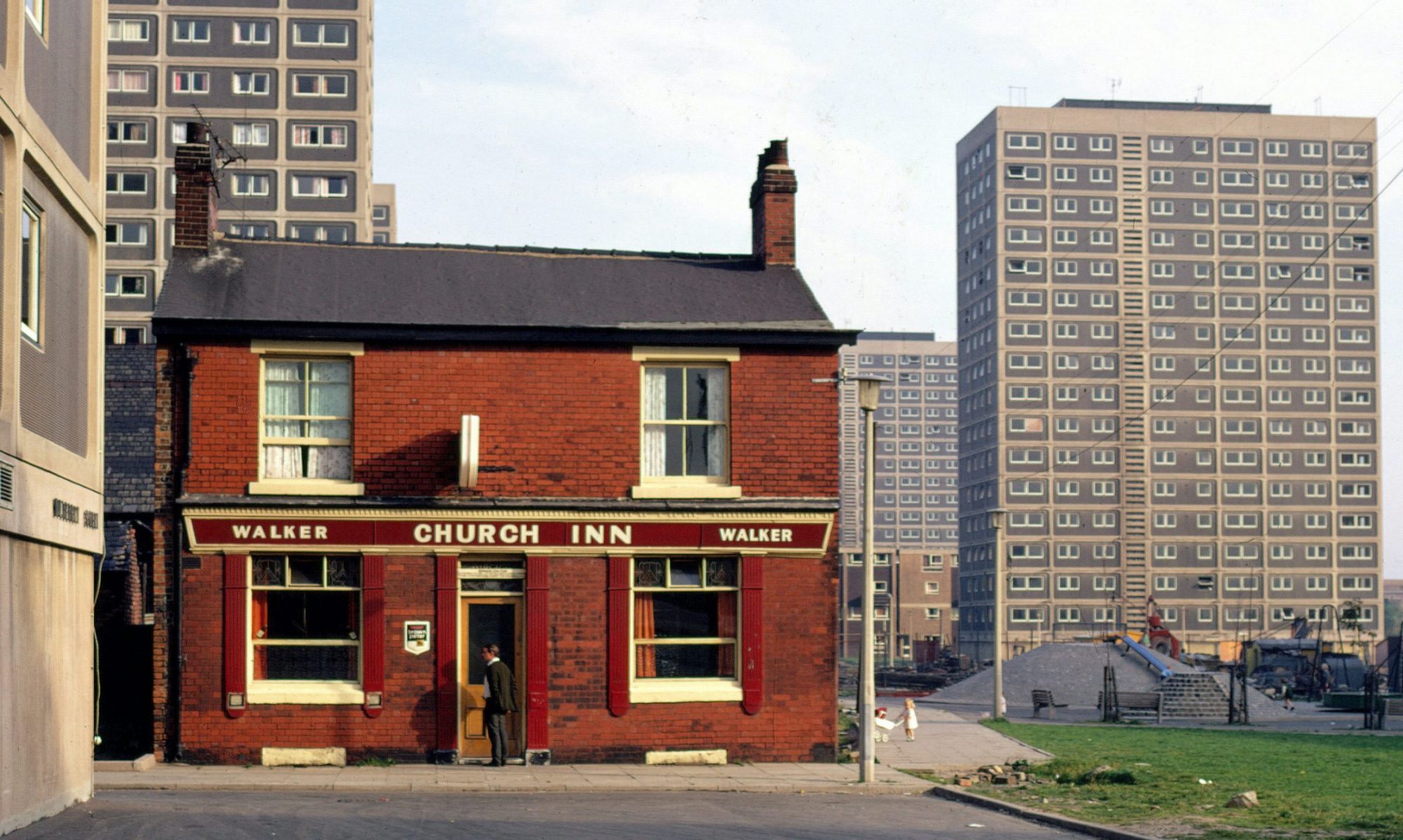by Daniela Atzori and Laura Janicka
Photograph: Michael Goodger, Back yard, 1969.
The event took place on Friday the 20th of January. We were welcomed with hot coffee and refreshments. At 9.30 Tanja Poppelreuter and Alexandra Mitchell introduced us to the Modern Backdrop project and outlined the plan for the day.
The first speaker of the day was Miles Glendinning with his presentation on “1960s Salford: Slum Redevelopment, Local Political Power, and ‘Everyday’ Modernist Design”. Miles is a Professor of Architectural Conservation at the Edinburgh School of Architecture and Landscape Architecture at the University of Edinburgh. His research focuses on the history of social housing during the ‘long 20th century’ and he is currently involved in a heritage lottery funded initiative “The Tower Block UK” that aims to provide an archive of images, experiences, and memories of the continuously disappearing tower blocks in the United Kingdom.
The talk outlined the history of social housing in Salford and the political tensions between the local authorities of Salford and Manchester and the architects of that time. Due to decreasing population in Salford, the council had to build dense and high to prevent population loss and be overtaken by Manchester resulting in the tall rise buildings to become the “vernacular” of Salford. He explores the tensions between the governments and architects who wanted to keep prestige, while the council wanted new housing resulting in a top-down diversity of form, from “point blocks” to “brutalist-Barbican” rather than a bottom-up demand.
Charlotte Wildman presented her work on “Mean Streets: Crime Deviance and Homes in Manchester and Salford”. Dr. Charlotte Wildman is Senior Lecturer in Modern British History at the University of Manchester, and her research focuses on the experiences of working-class women and the use of home for a range of minor crime activities as a way of standing up against inequalities they endured during 1918-1979.
She suggests that the statistics of minor crime in working class domestic settings, such as theft and shoplifting, is highly undocumented. However, the role of petty crime should be given more attention to paint a more accurate picture of home life in the 1900s which is currently dominated by upper class representation. Charlotte suggests that acts of deviance born out of necessity to survive formed a basis of community belonging in the working-class neighbourhoods. Minor crimes were a form of ‘caring’ for the community and of providing for their families meaning that the working-class family life was built upon a very different set of values when compared to upper class lifestyles.
The talk after lunch was given by Darren Newbury, he is a Professor of Photography at Birmingham City University. His research focuses on the works of the photographer Bryan Heseltine. His talk started with an insightful story on how he came across this artist and how his research project began; Bryan Heseltine was born in South Africa and later in his life studied in England, in 1940 went back to South Africa to study photography. In late 1940s, early 50s he began photography as a hobby and then was enticed by the South African Institution for Race Relations to photograph housing conditions; photos include portraits, housing structures, interiors, sanitation, work, and culture.
Heseltine’s photographs were exhibited on several occasions: first in Cape Town in 1952 as a mean to fight for better living conditions, and later in London in 1955, where the aim was to promote the anti-apartheid movement, highlighting the two political stances in the way they have been presented at two distinct locations.
John van Aitken and Jane Brake presented their work “Joy and Division in Salford: Visualising 21st century property-led development” through a formal presentation followed by a poem.
John is a Principal Lecturer and the Academic Group Lead for Media in the School of Journalism, Media, and Performance at the University of Central Lancashire. Jane is a Senior Lecturer of Art and Performance at the Manchester Metropolitan University. They are both part of the Institute of Urban Dreaming and based at the Pendleton Estate in Salford. The Insitute of Urban Dreaming is an inter-disciplinary project that promotes collaborations to start a conversation about social cleansing and displacement caused by development as well as the privatisation of public housing and their respective consequences.
John and Jane’s talk focused on Pendleton to bring attention to the gentrification that is happening in Salford. The district of Pendleton is unkept and neglected with common stories of demolitions. The developments are ruled by the politics of vision and sugar-coated in a narrative of a better life. However, rather than being community-shaped, where the residents wanted change with the possibility of retrofitting, the council responded with demolitions and evictions that resulted in the loss of neighborhood support, familiarity and belonging. They ask the question of who determines value and what is deemed as valuable in the eyes of the state.
Overall, the workshop provided a very insightful experience through a multi-disciplinary approach to paint a wider picture on the realities and perspectives on the matter of social housing and slum clearance in Britain. By exploring the evolution of the built form and the lived experiences of social housing and slum dwellers, we can begin to ask ourselves how these topics inter-relate to each other:
How does social status affect our experience of belonging in a social housing setting? How does the perception of social housing and its dwellers create conflicts about the determination of value? How our backgrounds determine the place we live in and who determines where and how we should live? Highlighting the complexity of the reality of social housing and slum dwelling in the UK and around the world.



One Reply to “Review of our workshop: Slums, Slum Clearance, and Slum Dweller in Britain (1950-1975) ”